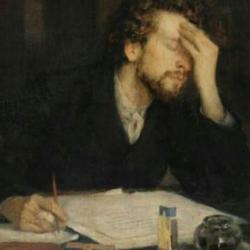Beowulf reflects the tensions between the Christian culture spreading throughout Northern Europe and the pagan cultures into which it came into conflict. The poem has its place within this clash of civilizations in the first 500 years AD. It is a product of the history of missions. The Germanic presence in Northern Europe posed a significant challenge to Christian missionaries, writers, and poets, and this challenge had several dimensions to this challenge, which are well described by Peter Brown at the end of his Rise of Western Christendom.
On the one hand, there was the intellectual challenge. Christianity originally arose within the Greco-Roman sphere, and even though it was Jewish, the Judaism in which Jesus and Paul operated was nestled within the Roman Empire, and had taken much of its character from conflicts with various Gentile powers over several centuries. It was fairly easy to make sense of Christianity within a Greco-Roman context, and there was even biblical warrant for seeing the empire as a Providential context for the rise of the church (Daniel 2, 7, e.g.).
But the Germans posed a new problem: how could the Germanic peoples who were invading and taking over the civilization of the classical world be fit into a Christian account of history? What role did they play? Some Christian writers attempted to show that the Lord had raised up the Germanic tribes to discipline and punish a degenerate Roman empire. But once the Northern tribes convert, how does one make sense of the German past? Was it on par with Greco-Roman civilization as a preparation for the gospel?
There was also a political dimension to this problem. As Brown points out, the Northern European kings who promoted Christianity and protected the church depended on genealogy for their legitimacy. Their pagan past gave them legitimacy in the Christian present. As a result, the pagan past could not merely be rejected without undermining their present basis of power. Further, the pagan past, expressed in oral legends and poems—very little was written—provided the “rule book” for aristocracy, embodying the ethos of the ruling class, which was shaped by these poems and sagas and legends and epics. As Brown puts it,
They knew very well what it was to be noble. They grew up in an overwhelmingly oral culture which was awash with stories and maxims. These told them how to behave as noble men and noble women. To be noble was to stand out. It was to live well and to be seen by others to live well. It was to foster with gusto the memory of a past which lay on the edge of the Christian present. This was a past which was always a little larger than life. It was a past where human glory, human tragedy, and the working out of human obligations were so much more vivid and so much more clear-cut, so much more brimming over with magnificent lack of measure, than was the grey, Christian present. To be noble was to toast one’s companions with great drinking-horns that carried as much liquor as a present-day bottle of Moselle; to engage in high talk and loud laughter; to listen to the ancient sound of the harpist.
Thus, Germanic rulers especially had a vested interest in maintaining the stories and legends that supported their power and their way of life. Charlemagne, for instance, saw himself as “Roman.” Yet according to Einhard he had “the unwritten laws of all the tribes that came under his rule to be compiled and reduced to writing. He also directed that the age-old, non-Latin poems in which were celebrated the warlike deeds of the kings of ancient times should be written out and preserved” (Brown, 477).
This preservation included not only the exploits of ancient kings and warriors but the exploits and characters of the pagan gods. In contrast to the Mediterranean world, where Christian apologists hammered the pagan gods of Greece and Rome, the gods of the North were treated as part of a solemn past. Peter Brown says: “They were seen as part of a glorious past. The past still gave a charge to the present. Hence the gods remained. Solemn figures even in their decline, they were like an ancient dynasty which had once ruled the earth until forced to abdicate in favor of the Christ of modern times. Without a touch of the gods ‘in the blood,’ as it were, modern kings could not be great. And if they could not be great, they could not act as effective defenders of the Church.”
Thus occurred the strange phenomenon that the pagan legends and sagas and epics of Northern Europe were written down, usually for the first time, by Christian clergymen:
there is not a word which was written about northern paganism that did not pass through the pens of Christian monks and clergymen. Apart from the writers of runes . . . the clergy remained the only literate class in northern Europe. And yet it was the clergy who went out of their way to consign to writing—and so have made available to us—all that we know of the pre-Christian narratives, the poetry, and the laws of Ireland, England, Scandinavia, and Germany.
Brown argues that
those who wrote down the legends and poetry of the pre-Christian past in Ireland, Anglo-Saxon England, and Iceland were not grudging recorders, catching in written words the last vestiges of a pagan mythology doomed to extinction by the coming of the Christian church. The situation was not like that at all. Rather, Christian monks and clergymen should be seen as the last great myth-makers of northern Europe. They transformed a living pagan past, so as to use it in their own, Christian present.
Hence, the legends and epics of heroic Northern Europe became part of the heritage of Christendom. This did not come without considerable modification. The image of the hero in Beowulf, as we’ll see, is quite other than the image of the heroic warrior in the Greek and Roman epics. Northern Europe formed a new kind of hero, the saint, shaped by the cult of the saints that was a huge influence in the conversion of the Northern tribes as a power that challenged and stood outside the brutal power of the warriors. Yet, alongside the legends of the saints, Christian writers did preserve the epics of the pagan past.
Beowulf was thus by no means the only example of this. It is the most subtle and interesting example of the clash and tension between the pagan past and the Christian present. But before looking at Beowulf, let me take a brief digression and talk about a couple of other works that fit into this setting, works that handle the tension and clash very differently from Beowulf.
Heiland, or the Savior, a telling of the story of Jesus, translated/contextualized for the Germanic warrior culture in which it was written: 9th century. Jesus is throughout considered a “Chieftain” and the disciples are depicted as his earls and warriors. The feasts are Saxon, with ring givers and apple wine, and an angel warns John the Baptist not to drink hard cider all his life. Heaven is “God’s meadow,” and Jesus’ teaching is described as “runes and his teaching on prayer is described in terms of teaching a new “spell.” So there is a surface use of Saxon heroic and epic motifs.
A more extended example will further illustrate. In song 58, when Jesus is being arrested, Peter intervenes to protect him, and goes beserk. As the editor points out, he acts like one of those Nordic warriors called the “berserkers” who were transformed by their battle rage into something quite inhuman. He cannot contain his rage and is so angry he cannot speak, and the description is a typical epic battle description with vivid wound and lots of blood. The poet goes far beyond the gospel account not only in its detail but in the threat to the man’s life.
Like Beowulf, Heiland refers occasionally to fate or wyrd, the force that determines when a man is going to die. This pagan concept is linked up with the sovereignty and creativity of God into a synthesis. The basic idea of wyrd is transformed into something like natural law: God initiates everything, puts new processes to work, but then they develop according to an immanent power. God brings things into existence, but the essence and length of existence come from fate. Talking about John the Baptist, the poet says that the “power of God . . . .was felt” and Elizabeth became pregnant, but then “the woman awaited the workings of fate,” that is, the day of birth. Death is especially governed by wyrd.
But it’s also here that we begin to see more of what the poet is doing. It might appear that he is bringing the story of Jesus into a heroic framework, and he is, but even as he’s doing that he’s transforming the heroic framework. Within this apparent germanization of the gospel, the poem aims at an evangelization of the Saxons.
As noted, the warrior code is all here: fate (wyrd) has a prominent place, death is certain but the timing is impossible to know. But Jesus overcomes fate. Mortality is strongly linked to blindness, and the problem of ignorance of fate is a big one. Jesus overcomes blindness, heals blindness, and knows His own fate, how and when he will die in Jerusalem. When he comes to Jericho and heals a blind man, it is described as a triumph over fate. Christ cures the blindness that is inherent in the human condition, and this makes him the greatest of all heroes, as He fulfills the hopes and aspirations of the warrior culture of the Saxons. Unlike John’s birth, Jesus’ birth is described without reference to fate at all. The poet emphasizes the fact that he does all things by his own power: nativity. He has unique and intrinsic power over all things
Another example: The poem contextualizes the sermon on the mount to the warrior ethic of the Saxons. It makes the sermon as palatable to warriors as as possible, but also challenges the whole ethic at a fundamental level. Love for enemies and the prohibition of vengeance strike at the foundations of the warrior culture.
There are a number of allusions to Boniface’s felling of the tree of Woden in the poem. Words for “felling” trees are used a number of times, but instead of felling trees, pagans are felled, and the axe is the word of Jesus. Christ is presented as being greater than Woden. The dove on His shoulder rivals and replaces the raven on the shoulders of Woden. He is a teller of secrets and revealer of runes. He walks on water and comes from heaven, like Thor. Implicitly, there’s an overturning of the pagan religious order.













